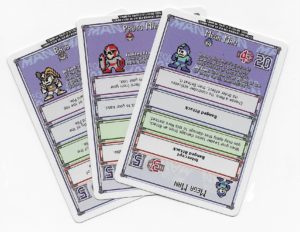Gaming is a unique form of media that doesn’t translate  well into other forms. Just look at the glut of movies based on video game properties and you will see a forest of failures, with some minor successes. The main reason that this shift is tough to make is because translating the property to another medium loses a very important part that makes video games sing: the player. This has caused a minor revolution in the other side of the gaming world, where characters we know and love move from their pixelated and digital roots into the realms of cards and tokens.
well into other forms. Just look at the glut of movies based on video game properties and you will see a forest of failures, with some minor successes. The main reason that this shift is tough to make is because translating the property to another medium loses a very important part that makes video games sing: the player. This has caused a minor revolution in the other side of the gaming world, where characters we know and love move from their pixelated and digital roots into the realms of cards and tokens.
Mega Man Pixel Tactics shows that while the blue bomber didn’t quite make the translation into the 3D realm, the antics and fun of the Mega Man franchise translate great into a 2 player versus card game. The game comes in 3 versions with a red and blue deck for each version. The Mega Man version of Mega Man Pixel Tactics features 28 characters from Mega Man 1-3, with the Proto Man version featuring 28 characters from Mega Man 4-6. The Bass version of the game, which was a stretch goal for backers $35 and above, features 28 characters from throughout the Mega Man series in their 8-bit form.
![]() One of the things that makes Mega Man Pixel Tactics awesome is that all cards can fill dual roles, either that of a Leader, or a Hero. This is determined based on the position the card is played on a 3×3 grid, with the Leader in the center, and Heroes around the leader. Where the tactics come into play is how you place you Heroes in relation to your hero, and of course, your opponent. Melee characters do the best in the vanguard, the row in front of the Leader, where ranged characters do the best in the rear, the row behind the leader. The left and right of the Leader is the flank.
One of the things that makes Mega Man Pixel Tactics awesome is that all cards can fill dual roles, either that of a Leader, or a Hero. This is determined based on the position the card is played on a 3×3 grid, with the Leader in the center, and Heroes around the leader. Where the tactics come into play is how you place you Heroes in relation to your hero, and of course, your opponent. Melee characters do the best in the vanguard, the row in front of the Leader, where ranged characters do the best in the rear, the row behind the leader. The left and right of the Leader is the flank.
Each card has different abilities depending on not only how you play them, be it Leader of Hero, but also where you play them. Fan favorite Snake Man has a Melee attack in the Vanguard position, but a ranged attack in the Rear and Flank positions, with the ability to move to move after successfully landing an attack. As a Leader, he can force a Hero to move positions while healing them. Because of this versatility present in just a single card, having two identical 89 card decks means a lot of different gameplay outcomes.
A best of 3 set takes about 30 minutes to complete, and no two games are ever the same. Even after vigorous shuffling, I never saw the same card twice. Having the option to play a card as a Leader or as a Hero means you get a lot of longevity out of even a simple hand. The hardest part of the game is keeping track of player actions, as you only get 2 per turn. This leads to some interesting strategy too, as you can forgo drawing a card to instead play two cards at once. When these types of decisions are paired with the rapid fire gameplay, it almost feels like the oft-forgotten Mega Man Battle Network series from the Gameboy Advance years.
Pixel Tactics, as a system, has been around for a while, usually featuring original fantasy characters and tropes, whereas this version has a nice coat of Mega Man paint. The roster of characters between the three versions of the game has some deep cuts into Mega Man history, including the modern retro-releases of Mega Man 9 and an $8 add-on featuring the Stardroids. Adding a tactical element to a property known for its platforming is a bold move, but Mega Man Pixel Tactics brings to life a side of Mega Man that isn’t known to many outside of the Battle Network franchise.
All three versions of Mega Man Pixel Tactics, and the standard and deluxe versions of Pixel Tactics, can be purchased on Amazon.



